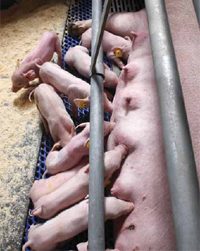Always looking ahead to the next litter

Feeding for better reproduction starts immediately after farrowing. Theory and practice show that if lactating sows reach a high feed intake with feed rich in starch, the number of piglets born at the next cycle is improved.
By Hans Aae, head of nutrition, Vitfoss, Denmark
Nutrition influences litter sizes to a great extent, and the question is, how we can improve the number of piglets
| Feeding in lactation periods in order to secure better reproduction in the subsequent cycle is very important. |
born. The implantation of embryos/ foetus seems to be completed between week two and three after insemination; after that time the largest influence on number of piglets born is mainly due to reduction of virus infection.
Consequently, the management of nutrition in order to secure the optimal number of embryos is considered to take place from after weaning until three weeks after insemination. This, however, may already be too late. Feeding in lactation periods in order to secure better reproduction in the subsequent cycle is very important.
Feeding for more hormones
It is often discussed how much feed the sows need right after farrowing. The milk production is not peaking, so from this perspective a moderate feed increase is recommended. Taking into consideration the subsequent reduction of cycles, however, sows need to be fed high amounts of feed after farrowing (without constipation of course). This means that a steep feeding curve with a daily increase of 0.5-1.0 kg feed the first week will work out positive for the sow.
A recent trial shows the importance of a feeding strategy in lactation. In the trial, sows were fed either ad lib or restrictively at the beginning of lactation (first three weeks) or late in lactation last week. Group one (AA) were fed ad lib for the whole period. Group two (AR) was fed ad lib for the first 21 days and restrictively for the last seven days of lactation, and finally group three (RA) was fed restrictively in the first 21 days of lactation and fed ad lib in the last seven days of the lactation period. The response parameters in this trial were an Insuline-like Growth Factor (IGF-1) as an indicator for nutritional status of the sow, luteinic hormone (LH) peaks as an indicator for level of reproduction hormones and of course time for weaning to heat, number of eggs released and survival of foetus as performance parameters.
Better reproduction
Table 1 shows that ad lib feeding causes the highest level of IGF1 in both periods; this result is not surprising. There is, however, a clear connection between IGF1 and LH-peaks especially for the first period of lactation. Other trials also show, that IGF1 is modulated by starch level in feed.
The first conclusion is thus that feeding high level of feed rich in starch at the beginning of the lactation period provides a higher level of reproduction hormones.The conclusion is supported by Table 2, where the relation between feed intake in the first two weeks of lactation, LH-peaks at day 14 and number of follicles at day 14 is illustrated.The second conclusion is clear, i.e. higher numbers of LH-peaks result in more follicles, and they are formed early in lactation for the next reproductive cycle.
Reduced number of eggs
Considering the above facts it can be concluded that the feed intake early in lactation influences the number of follicles formed.
When focusing on Table 1again the indirect conclusion can be drawn that restrictive feeding in late lactation will reduce the number of eggs released. The number of follicles formed must be high due to high LH peaks: they are, however, simply not released due to the negative energy balance (NEB) of the sow.
Secondly, NEB sows have a higher foetus mortality, illustrated by the fact that 2/3 is surviving compared to more than 85% surviving, when sows are fed ad lib by the end of lactation.
The third conclusion is consequently that ad lib feeding by the end of lactation results in an increased number of eggs released and at better survival rate.
Source: Pig Progress magazine Volume 26. No. 3











